a. Isomers (A) and (B), C10H12O, are isolated form the oil of bay leaf. They are insoluble in aq. NaOH and decolourise Br2/CI4 and KMnO4. Each is vigorously oxidised to p-anisic acid, (p−MeOC6H4COOH). Ozonolysis (A) and (B). Identify A and B
To solve the problem, we need to identify the isomers A and B, which have the molecular formula C₁₀H₁₂O, and are derived from the oil of bay leaf. The key points provided in the question are:
1. Both isomers are insoluble in aqueous NaOH.
2. They decolorize bromine water and KMnO₄, indicating the presence of unsaturation (double bonds).
3. Upon vigorous oxidation, both isomers yield p-anisic acid (p-MeOC₆H₄COOH).
4. Ozonolysis of both isomers is mentioned.
Step 1: Determine the structure of p-anisic acid.
- The structure of p-anisic acid is given by the formula p-MeOC₆H₄COOH, which indicates that it has a methoxy group (-OCH₃) and a carboxylic acid group (-COOH) attached to a benzene ring.
Step 2: Analyze the molecular formula C₁₀H₁₂O.
- The molecular formula suggests that the compound contains a benzene ring (C₆H₅) and additional carbon and oxygen atoms. The presence of 10 carbons and 12 hydrogens indicates unsaturation.
Step 3: Consider the possible structures for isomers A and B.
- Since they are isomers, they will have the same molecular formula but different structural arrangements. We can consider the following structures:
- Isomer A: A possible structure could be a compound with a methoxy group and a double bond in the alkyl chain.
- Isomer B: Another structure could be a different arrangement of the same groups, possibly with the double bond in a different position or configuration (cis/trans).
Step 4: Propose specific structures for A and B.
- Isomer A: 4-methoxy-1-hexene (cis configuration)
- Isomer B: 4-methoxy-1-hexene (trans configuration)
Step 5: Verify the oxidation reaction.
- Both isomers A and B, when oxidized vigorously, yield p-anisic acid. This indicates that the double bond can be oxidized to form the carboxylic acid and methoxy group.
Step 6: Consider ozonolysis.
- Ozonolysis of both isomers would break the double bond and yield aldehydes. For both isomers, the ozonolysis products would include aldehydes that can also lead to the formation of p-anisic acid upon further oxidation.
Conclusion:
The isomers A and B are:
- Isomer A: 4-methoxy-1-hexene (cis)
- Isomer B: 4-methoxy-1-hexene (trans)
2. They decolorize bromine water and KMnO₄, indicating the presence of unsaturation (double bonds).
3. Upon vigorous oxidation, both isomers yield p-anisic acid (p-MeOC₆H₄COOH).
4. Ozonolysis of both isomers is mentioned.
- The structure of p-anisic acid is given by the formula p-MeOC₆H₄COOH, which indicates that it has a methoxy group (-OCH₃) and a carboxylic acid group (-COOH) attached to a benzene ring.
- The molecular formula suggests that the compound contains a benzene ring (C₆H₅) and additional carbon and oxygen atoms. The presence of 10 carbons and 12 hydrogens indicates unsaturation.
- Since they are isomers, they will have the same molecular formula but different structural arrangements. We can consider the following structures:
- Isomer A: A possible structure could be a compound with a methoxy group and a double bond in the alkyl chain.
- Isomer B: Another structure could be a different arrangement of the same groups, possibly with the double bond in a different position or configuration (cis/trans).
- Isomer A: 4-methoxy-1-hexene (cis configuration)
- Isomer B: 4-methoxy-1-hexene (trans configuration)
- Both isomers A and B, when oxidized vigorously, yield p-anisic acid. This indicates that the double bond can be oxidized to form the carboxylic acid and methoxy group.
- Ozonolysis of both isomers would break the double bond and yield aldehydes. For both isomers, the ozonolysis products would include aldehydes that can also lead to the formation of p-anisic acid upon further oxidation.
The isomers A and B are:
- Isomer A: 4-methoxy-1-hexene (cis)
- Isomer B: 4-methoxy-1-hexene (trans)
Topper's Solved these Questions
- ALCOHOL,PHENOL AND ETHERSBOOK - CENGAGE CHEMISTRY ENGLISHCHAPTER - ALCOHOL,PHENOL AND ETHERSEXERCISE - Exercises Concept Application
33 Videos
- ALCOHOL,PHENOL AND ETHERSBOOK - CENGAGE CHEMISTRY ENGLISHCHAPTER - ALCOHOL,PHENOL AND ETHERSEXERCISE - Exercises Linked Comprehension
60 Videos
- ALCOHOL,PHENOL AND ETHERSBOOK - CENGAGE CHEMISTRY ENGLISHCHAPTER - ALCOHOL,PHENOL AND ETHERSEXERCISE - Solved Examples
17 Videos
- ALIPHATIC AND AROMATIC ALDEHYDES AND KETONESBOOK - CENGAGE CHEMISTRY ENGLISHCHAPTER - ALIPHATIC AND AROMATIC ALDEHYDES AND KETONESEXERCISE - Archives Subjective
26 Videos
Similar Questions
Knowledge Check
Compound (A) C10H22O2 is insoluble in aq. NaOH but not in NaHCO3. Treatment of (A) with DMSO ⎛⎜ ⎜⎝CH3−O∣∣S−CH3⎞⎟ ⎟⎠ in alkali give (B) C11H14O2. Treatment of (A) with strong alkali alone give an isomeric compound ( C). When (A) is refluxed with HI, CH3I is obtained, compound (B) is insoluble in alkali and decolourises Br2/CCl4. (B) on treating with strong base gives (D), an isomer of (B). Ozonolysis ( C) of gives (E), C8H8O3 and isomer of vanilline. Ozonolysis of (D) gives (F) C9H10O3, which is identical with product of methylation of vanilline (4-hydroxy-3-methoxy benzaldehyde).
Compound (B) is :A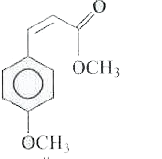 B
B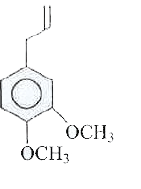 C
C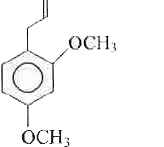 D
D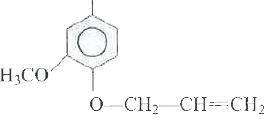
Compound (A) C10H22O2 is insoluble in aq. NaOH but not in NaHCO3. Treatment of (A) with DMSO ⎛⎜ ⎜⎝CH3−O∣∣S−CH3⎞⎟ ⎟⎠ in alkali give (B) C11H14O2. Treatment of (A) with strong alkali alone give an isomeric compound ( C). When (A) is refluxed with HI, CH3I is obtained, compound (B) is insoluble in alkali and decolourises Br2/CCl4. (B) on treating with strong base gives (D), an isomer of (B). Ozonolysis ( C) of gives (E), C8H8O3 and isomer of vanilline. Ozonolysis of (D) gives (F) C9H10O3, which is identical with product of methylation of vanilline (4-hydroxy-3-methoxy benzaldehyde).
Structure of compound (A) is :A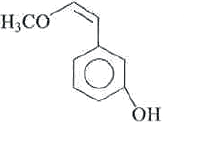 B
B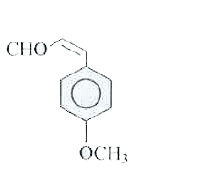 C
C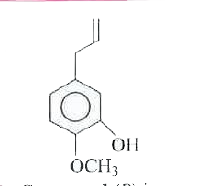 D
D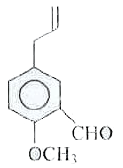
Compound (A) C10H22O2 is insoluble in aq. NaOH but not in NaHCO3. Treatment of (A) with DMSO ⎛⎜ ⎜⎝CH3−O∣∣S−CH3⎞⎟ ⎟⎠ in alkali give (B) C11H14O2. Treatment of (A) with strong alkali alone give an isomeric compound ( C). When (A) is refluxed with HI, CH3I is obtained, compound (B) is insoluble in alkali and decolourises Br2/CCl4. (B) on treating with strong base gives (D), an isomer of (B). Ozonolysis ( C) of gives (E), C8H8O3 and isomer of vanilline. Ozonolysis of (D) gives (F) C9H10O3, which is identical with product of methylation of vanilline (4-hydroxy-3-methoxy benzaldehyde).
A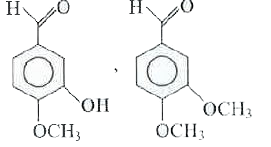 B
B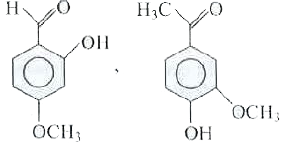 C
C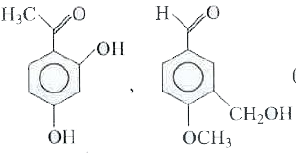 DNone of these
DNone of these
Identify A and B.
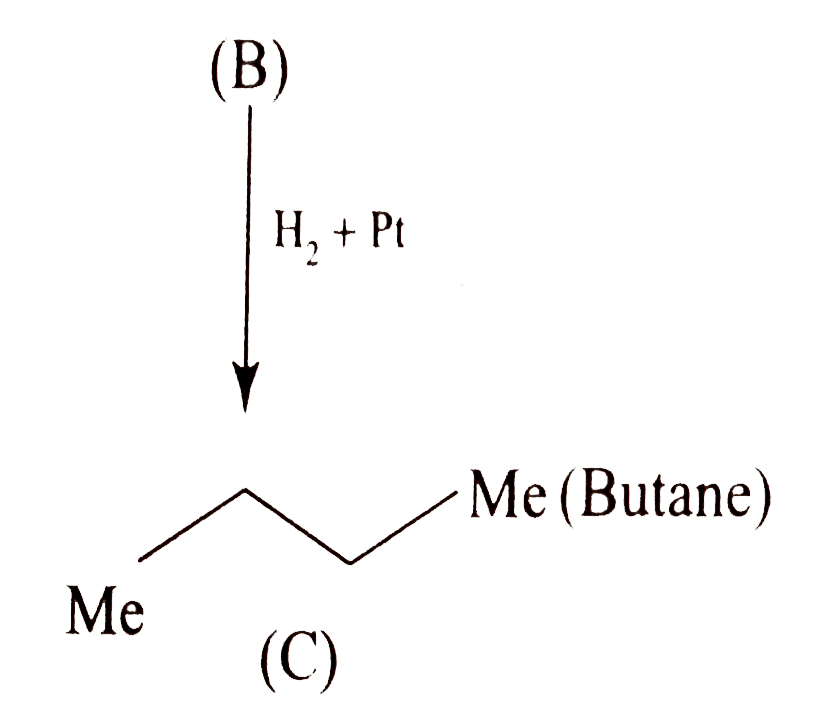
Gas (B) gives test for unsaturation, i.e., it decolourises Br2 water and aqueous KMnO4 solution.
View SolutionAn organic compound (A) (C5H7OCl) reacts rapidly with ethanol to give (B) (C7H12O2). (A) also reacts with water to produce an acid which reacts with bromine to give (C ) (C5H8Br2O2). (B) on boiling with H2SO4 forms an acid (D). When (D) is oxidised with KMnO4 an acid (E ) (C4H6O3) is produced. On mild heating, (E ) gives (F) (C3H6O) which cannot be oxidised by ammoniacal AgNO3. Identify the compounds (A) to (F).
View SolutionCompound 'P', C7H8O is insoluble in water, dilute HCl and NaHCO3 . It dissolves in dilute NaOH . When P is treated with Br2−H2O , it converts rapidly into a compound of formula C7H5OBr3 . Identify structure of :
View SolutionCompound (A) C7H8O is insoluble in aqueous NaHCO3 and dissolves in aqueous NaOH and gives a characteristic colour with neutral FeCl3 . When treated with Br2 (A) forms compound (B) C7H5OBr3 .
The structure of compound (B) would be :
View SolutionCompound (A) C12H20, discharges the colour of Br2−H2O and cold KMnO4 . On reduction with H2/Pt it gives compound (B) C12H22 . A on ozonolysis give cyclohexanone. Find structure of A :
View Solution